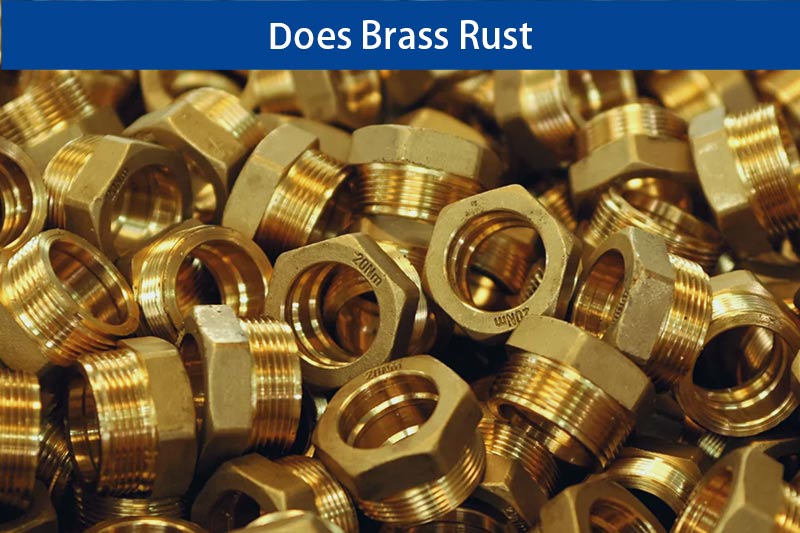Wondering “does brass rust”? Unlike iron, brass cannot rust due to its iron-free composition—yet it still corrodes and tarnishes. This guide reveals how to spot early corrosion, prevent damage, and choose the right brass alloy. Learn practical solutions to protect your brass items from decay and extend their lifespan. Dive in to master brass maintenance!
Content:
Contents
Does Brass Rust or Corrode? Understanding the Difference
Keep your brass items in tip-top shape: Knowing the difference between rust and corrosion is important, as only specific types of decay are a threat to your brass.
Why Brass Doesn’t Rust but It Can Corrode
Unlike iron, brass does not rust (because brass contains no iron). However, brass still oxidizes. Its surface can develop a blue- or greenish-green patina upon exposure to air and moisture, which ultimately serves as a barrier to prevent further metal loss rather than induce it.
Brass Tarnishing vs. Iron Rusting
Brass becomes tarnished when the copper in the alloy reacts with oxygen, sulfur, or moisture. The result is darkened or discolored patches on the surface — but unlike rust on iron, these don’t flake off. To minimize tarnishing, shield from sulfur and coat to prevent oxygen exposure.
Recognizing Brass Corrosion Early
Look for dullness, brown or black spots, and eventually a greenish patina that may form where water pools. Recessed spots and joints are among some of the early indicators. Tiny green dots signal it is time to take quick action to stave off deeper damage.

What Causes Brass to Corrode?
Fast tracks to brass deterioration: Brass can also be corroded if certain circumstances facilitate a faster rate of corrosion. Knowing these can help you better secure your applications.
Factors That Cause Corrosion to Happen More Quickly
High humidity (slightly above 65%), salt in the air, and rapid changes in temperature can all increase the likelihood of corrosion through the addition of moisture into the mix. Quicker tarnishing is also brought on by industrial sulfur emissions and indoor pollutants. Maintain humidity below 55% and stay out of polluted areas whenever you can.
Water Exposure and Dezincification
Long-term water exposure causes brass’s zinc to dissolve, weakening the brass and forming a pink, porous surface. Chlorinated water accelerates this process. Brass should always be dried after contact with water, and fixtures should be protected with waxes.
Pollutants and Chemical Damage
Brass is darkened and its surface is stripped by air pollution containing sulfur and nitrogen compounds. The finish is also damaged by household cleaners that contain ammonia or acids, such as vinegar or lemon juice. Handle with clean cotton gloves, and clean with a special, pH-neutral cleanser.
How Does Brass Hold Up against Other Metals in Terms of Corrosion Resistance
Knowing the benefits and limitations of brass allows you to select the correct material for every job.
Brass vs. Stainless Steel: Durability
Stainless steel stands up better than brass to water-based corrosion, but brass handles exposure to chloride well, making it great for marine hardware. Brass also has antimicrobial properties, which add to its list of applications in hospitals.
| Property | Brass | Stainless Steel |
|---|---|---|
| Saltwater Resistance | Moderate to Good | Variable (316 grade: excellent) |
| Atmospheric Corrosion | Forms protective patina | Excellent |
| Maintenance Requirements | Regular cleaning/coating | Minimal |
Brass, Bronze, and Copper – And When to Use Which
Brass, a metal far better suited to sulfur-laden air, usually fares better than pure copper, while bronze is preferable in a seawater setting. All form protective patinas at varying rates and in varying colors. Choose the alloy that fits your exact performance requirement—slower patina for decorative work, stronger for rough use.
Best Applications of Brass in a Corrosive Environment
Brass is a good choice in a room with humidity swings, and fixtures that capitalize on its antimicrobial properties. Silicon brass is also suitable for high-friction or chemical applications. Do not use brass in regions with high ammonia content water, or in constant contact with water, unless it is protected.
Corrosion tests can provide valuable data to compare brass with other metals, helping you choose the right material for specific environments
How To Keep Brass From Corroding
You can protect brass for decades by treating it right — here’s how.
Coatings and Sealants
Indoors use microcrystalline wax to repel moisture and pollution. Use UV-resistant lacquers for outdoor pieces, with a thin application. Specialist coatings like Incralac protect things that are touched a lot.
Effective Cleaning Methods
For unlacquered brass, a mixture of vinegar, salt, and flour should be rinsed with water, then well-dried after cleaning. A damp microfiber cloth is sufficient to clean lacquered surfaces. When cleaning is done, you should always reapply the original protective lacquer to avoid tarnish.
Controlling Your Environment
Keep indoor humidity between 40–55%. Store with silica gel, place air purifiers with carbon filters near display pieces, and do not expose brass near windows, vents, or kitchens.
Everyday Habits to Reduce Tarnish
Touch brass with clean hands or gloves. Wipe off items used on a daily basis and keep them in acid-free containers. Avoid exposing brass to ammonia and bleach, and store it with anti-tarnish strips.
How to Restore Corroded Brass
This is how to revive old brass that’s so grimy you may not want to remove if you wish to resurrect that old door handle. Here’s how you can reanimate it with hands-on solutions and, if necessary, professional help.
DIY Solutions For Light Tarnish
For light tarnish, create a paste of salt, flour, and white vinegar. Gently rub it on the surface in a circular motion with a soft cloth, and it will pull out discoloration without scratching.
Another idea: Cut a lemon in half, dust the cut side with baking soda, and rub directly on the brass. This combination removes tarnish quickly.
If the stains do not come off, apply a thin layer of ketchup to the area. Leave for 10-15 minutes, rinse, and buff to shine.
Professional Methods to Remove Heavy Corrosion on Brass
For deep corrosion or green verdigris, use commercial brass cleaners containing acid—oxalic or phosphoric. Always use gloves and work in a well-ventilated area. Be sure to follow the directions on the product to avoid harm.
Electrolysis is one way to remove corrosion non-abrasively to retain fine details and patina for antiques or other fragile pieces.
Another advanced method is ultrasonic cleaning—high-frequency sound waves clean small crevices that manual scrubbing can’t reach.
Restoration VS Replacement: How to Decide Wisely
Before investing time or money, verify that the item is valuable or functional enough to restore. Generally, only architectural brass of quality should be restored; discard mass-produced, valueless, or badly deteriorated pieces.
Examine for pink patches (dezincification) or pitting. If grime isn’t the main culprit and the problem is something structurally unsound, then cleaning is insufficient—the damage is beyond restoration.
Some decorative items may benefit from patina preservation, and gentle cleaning can keep their unique appearance without eliminating the history.
Brass in Tough Situations: Special Notes
Discover practical solutions to prevent brass from damage outside or in extreme weather conditions, thereby increasing its longevity.
Copper Alloys Outdoors and Marine
Outdoor brass fixtures near the coast should get marine-grade lacquer every six months; choose clear coats with UV protection to prevent corrosion and sun-fading.
To create a moisture barrier for other outdoor hardware, apply thin coats of carnauba wax in dry weather for best effect.
On marine installations, fitting sacrificial anodes (zinc or magnesium) close to brass helps corrode the anodes instead of the brass.
Performance of Various Brass Alloys in Corrosive Environments
Naval brass is tinted and offers greater resistance to seawater, which makes it ideal for use in marine hardware. Admiralty brass is resistant to stress corrosion cracking in ammonia or many amine systems. Choose each according to where the brass is going to be used.
| Brass Alloy | Composition | Corrosion Resistance | Best Applications |
|---|---|---|---|
| Red Brass (C23000) | 85% Cu, 15% Zn | Excellent general resistance | Plumbing, radiator cores |
| Yellow Brass (C26000) | 70% Cu, 30% Zn | Moderate, susceptible to dezincification | Decorative hardware, low-stress components |
| Naval Brass (C46400) | 60% Cu, 39% Zn, 1% Sn | High seawater resistance | Marine fittings, propeller shafts |
| Aluminum Brass (C68700) | 83% Cu, 15% Zn, 2% Al | Superior in seawater | Condenser tubes, desalination equipment |
Field Tests: Strength Over Time (How Long Brass Will Last)
Salt spray testing reveals that exposed brass tarnishes quickly, but it can last far longer if it is lacquered. Coastal homes: every 3-6 months; inland areas: up to three years before brass hardware tarnishes.
Brass pipes have an average life span of 40-70 years if the water is balanced; however, aggressive water reduces lifespan to 15-20 years since it accelerates corrosion.
Indicators You Should Replace Corroded Brass
Know when cleaning alone is not enough and it’s time to replace something for safety or reliability.
How to Identify Irreparable Brass Damage and Why
Keep an eye out for pits larger than 1mm, pink discoloration, or brittle spots—these point to serious internal damage. Perforated structural elements having these signs are not to be reinstated.
Twist or press gently on brass fittings; if they crack or feel brittle, it is time to replace.
What are the Safety Concerns of Using Heavily Corroded Brass?
Never ignore green crust or damaged brass in plumbing—it can leach metals into water. Immediately replace corroded brass in drinking systems.
Brass electrical connections that have corroded pose a fire risk due to overheating. Replace any part affected in wiring or outlets promptly.
Replace structural brass (handrails, load-bearing fittings) if corrosion is visible—these can fail to the point of causing an accident or injury.
FAQ
Does Brass Corrode in Saltwater?
Yes, salt water corrodes brass by stripping away zinc very quickly. Only naval brass is acceptable for continual marine use.
What Products Will Quickly Corrode Brass?
Brass is most readily attacked by ammonia, chlorides, and chemicals containing sulfur. Try to keep these separate from brass when you can.
Can You Restore Antique Brass?
Yes, but do so cautiously—employ only mild cleansers. For high-value antiques, have a professional take a look so you don’t harm the finish or patina.
Is Brass Safe for Food and Drink Use Once Corroded?
No—you shouldn’t use corroded brass for food or drink. It has the potential to leach out metals and create health issues; restore or replace the pieces before using.



